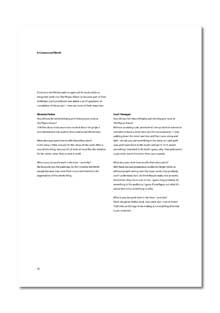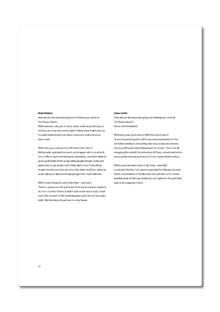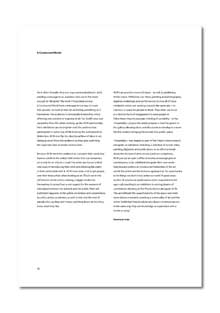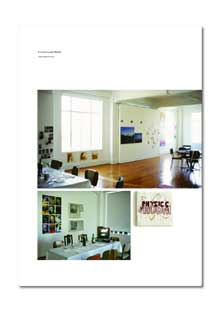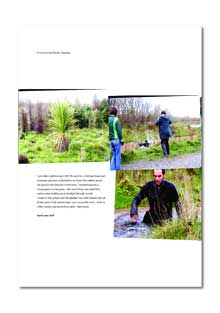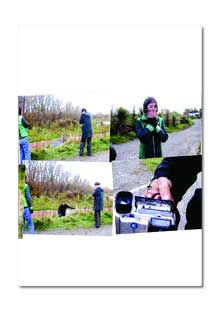 |
|||||||||
|
|
| ...Publications: Annual | ...The Physics Room Annual 2003 | ||||||||||||||
|
A Constructed World A Constructed World made an open call for local artists t o bring their work into The Physics Room to become part of their exhibition. Each contributor was asked a set of questions on completion of the project - here are some of their responses. Miranda Parkes How did you feel about bringing and showing your work at The Physics Room? I felt fine about it because I was excited about the project and interested in the work by the Constructed World team. What does your work have to offer that others don’t? In the show, I think actually for this show all the work offers a very similar thing, because it’s all kind of more like the material for the artists rather than a work in itself. What is your favourite work in the show - and why? My favourite was the paintings by the Constructed World people because they were fresh to me and related to the organisation of the whole thing . Scott Flanagan How did you feel about bringing and showing your work at The Physics Room? Without sounding rude, ambivalent. I always kind of wanted or intended to have a show here, but the circumstances - I was walking down the street and Jess and Finn came along and said - oh can you put something in the show so I said yeah sure, and I went back to the studio and got it. So it wasn’t something I intended to do that’s I guess why I feel ambivalent cause there wasn’t intention there, just surprise. What does your work have to offer that others don’t? Well these are just preparatory studies for larger works so without people having seen the larger works they probably won’t understand, but I do think they’re really nice as works themselves, they mean a lot to me . I guess they probably do something to the audience, I guess if you figure out what it ’s about then it has something to offer . What is your favourite work in the show - and why? Paul’s daughter, Stella’s work. How old is she - two or three? That’s the perfect age to be making art, everything after that is just contrived. Matt Walters How did you feel about bringing and showing your work at The Physics Room? Well someone asks you to show some work so you bring it in and you put it up and you ’re quite stoked when it gets put up . It’s quite interesting to see how it interacts with everyone else’s work. What does your work have to offer that others don’t? Well people approach my work and engage with it so what it has to offer is quite opinionated, something I wouldn’t think of, so it’s quite bold of me to say what people should come and appreciate in my work, I don’t think that’s how it should b e. People should come and see what they think and that’s what my work’s about, it’s about what people get from visual stimulus. What is your favourite work in the show - and why? There’s a picture on the wall over there it was framed, a picture of a tree in a blue frame , it didn’t look much but it really stood out in the context of the contemporary work here, it was quite bold. I like the idea of a picture in a big frame. Zane Smith How did you feel about bringing and showing your work at The Physics Room? Not at all intimidated. What does your work have to offer that others don’t? It was found by myself, and it was a reinterpretation of the exhibition medium, everything else was produced whereas this was all found and displayed out of context. These are all shopping lists which I’ve picked up off floors , streets and other areas, predominantly grocery lists from supermarket trolleys. What is your favourite work in the show - and why? I really like the Star Trek pieces especially the Klingon because of the combination of traditional craft with the sci-fi context and the le vel of skill was obviously not high but I thought that leant it an exquisite charm. A Constructed World Art is often thought of as one-way communication; an artist sending a message to an audience who are in-the-know enough to “decipher” the work. If Australian art duo A Constructed World have a message to convey, it’s more that anyone can look at their art and bring something to it themselves. The audience is intrinsically involved by virtue of having any reaction or response at all. For Geoff Lowe and Jacqueline Riva (the artists making up the ACW partnership), their exhibitions are incomplete until the audience has participated in some way. While blurring the audience/artist distinction, ACW also flip the directional flow of ideas in art, taking as much from the audience as they give, switching the expected roles of sender and receiver. Because ACW need the audience to complete their work, they have to confront the widely held notion that con temporary art is only for an elite in-crowd. The artists are forced to find new ways of introducing their work and allowing the public to feel comfortable with it. ACW have done a lot to get people over their insecurities when looking at art. This is not in the self-interest of the artists creating a bigger market for themselves, it comes from a real respect for the moment of interaction between the artwork and the public. Their self- published magazine Artfan, prints art reviews and commentary by critics, artists, academics, as well as kids and the kind of people who say they don ’t know anything about art but the y know what they like. ACW’s art practice covers all bases - as well as publishing Artfan (since 1993),they use video, painting and photography, organise workshops and performances. Across all of these media, the artists are working towards the same aim - to construct a space for people to think. They often use music as a familiar form of engagement to ease people in. Other times they incorporate a feeling of sociability - in the <hospitality> project the artists prepare a meal for guests in the gallery allowing ideas and discussion to develop in a more familiar context, bringing the private into public space. <hospitality> was staged as part of The Physics Room project, alongside an exhibition including a selection of recent video, painting, digiprints and publications. In an effort to break down the division of artist versus audience completely, ACW put out an open call for artworks, encouraging local contributions to be exhibited alongside their own works - rejecting any politics or constructed hierarchies of the art world. The artists see the inclusive approach as “an opportunity to let things we don’t know enter our work”. A great cross- section of amateur to professional artists responded to the open call, resulting in an exhibition involving dozens of contributors showing at The Physics Room alongside ACW. This act deflated the usual hierarchy of the space and went some distance towards asserting a universality of art and the artists’ belief that “everybody knows about contemporary art in the same way they use knowledge or experience with a movie or song.” Rosemary Forde View A Constructed World - Essay by Rosemary Forde as a PDF This essay originally appeared in The Physics Room Annual 2003 Order your copy today from The Physics Room ! Related April 29 - May 24, 2003
|
||||||||||||||

